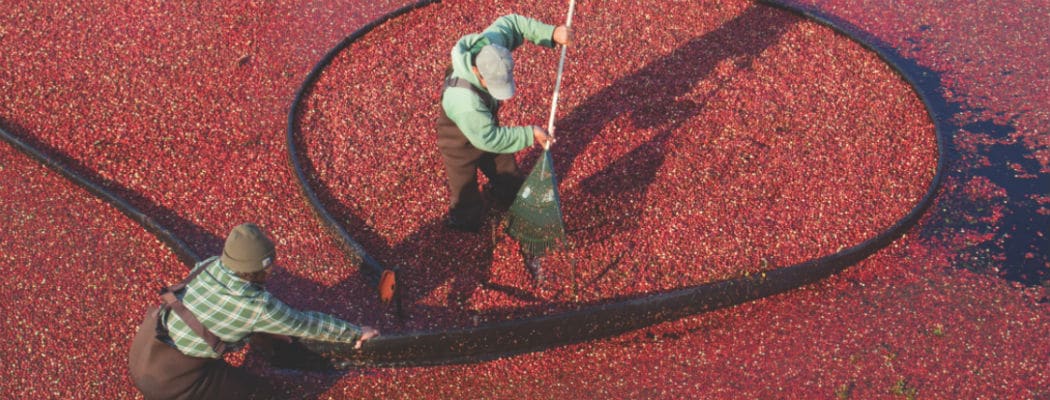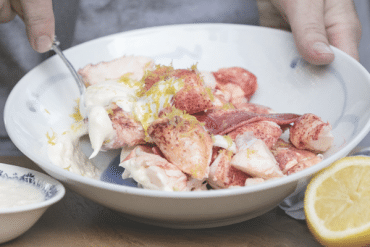The global reach of Nantucket’s native fruit.
 Every October, more than two million pounds of cranberries are harvested from the Nantucket Conservation Foundation’s bogs. That’s approximately 666 million berries being flooded, beaten, raked, washed, screened, and loaded within a month. While the harvesting methods have evolved from the fruit being tediously handpicked to efficiently machine collected, these cranberries grow from the very same vines that were farmed over a 150 years ago, back when Nantucket laid claim to the largest contiguous bog in the country. Today, these cranberry vines serve as a direct connection to an oft forgotten period of Nantucket history that the Conservation Foundation is committed to keeping alive. To do so, the cranberries that they harvest each fall end up in some pretty unexpected places.
Every October, more than two million pounds of cranberries are harvested from the Nantucket Conservation Foundation’s bogs. That’s approximately 666 million berries being flooded, beaten, raked, washed, screened, and loaded within a month. While the harvesting methods have evolved from the fruit being tediously handpicked to efficiently machine collected, these cranberries grow from the very same vines that were farmed over a 150 years ago, back when Nantucket laid claim to the largest contiguous bog in the country. Today, these cranberry vines serve as a direct connection to an oft forgotten period of Nantucket history that the Conservation Foundation is committed to keeping alive. To do so, the cranberries that they harvest each fall end up in some pretty unexpected places.
Apart from a relatively small portion sold to local merchants, all of the cranberries harvested on Nantucket are shipped off-island and sold to big fruit companies such as Ocean Spray, Decas, or, most recently, The Power of Fruit. Given the global reach of each of these companies, it’s entirely possible that when someone pours a glass of cranberry juice in Europe, the cranberries they are enjoying were harvested from bogs on Nantucket. Beyond juicing, freezing or drying, some of the island’s cranberries also get distilled down into pill form by nutraceutical companies selling them as rich anti-oxidant supplements that help fight heart disease, stroke, ulcers, urinary tract infections and gum disease.
Although new uses for cranberries continue to be innovated, the market has become increasingly flooded with new supplies of berries, driving down the price per pound. Until the early nineties, Massachusetts was the largest cranberry producer in the world, with Nantucket ranking near the top of the heap. During these boom days, a pound of cranberries could fetch up to eighty cents. Today, that number has fallen to between ten and fifteen cents. Who’s Nantucket’s main competitor in the country? Wisconsin.
 Cranberries thrive in harsh conditions. “It’s a tough old vine,” says Tom Lennon, the Nantucket Conservation Foundation’s director of finance and administration who has overseen the cranberry harvest for fifteen years. “It’s a cold weather crop. Ideally it loves ice with a layer of snow on top of it.” While Nantucket offers optimal soil conditions (cranberries love sand), the island cannot compete with Wisconsin when it comes to cold weather. Wisconsin also has younger vines, some of which have been genetically engineered to produce super cranberries. Meanwhile, Nantucket’s cranberries grow off the same vines that were harvested before the Civil War. As a result, Wisconsin has gone from producing the same number of cranberries as Massachusetts in 1992, to now growing twice as many.
Cranberries thrive in harsh conditions. “It’s a tough old vine,” says Tom Lennon, the Nantucket Conservation Foundation’s director of finance and administration who has overseen the cranberry harvest for fifteen years. “It’s a cold weather crop. Ideally it loves ice with a layer of snow on top of it.” While Nantucket offers optimal soil conditions (cranberries love sand), the island cannot compete with Wisconsin when it comes to cold weather. Wisconsin also has younger vines, some of which have been genetically engineered to produce super cranberries. Meanwhile, Nantucket’s cranberries grow off the same vines that were harvested before the Civil War. As a result, Wisconsin has gone from producing the same number of cranberries as Massachusetts in 1992, to now growing twice as many.
On the international front, Canada has also become a major player that dwarfs Massachusetts in production. “The only way out of it,” Lennon says of the competition, “is to get the cranberries out of the ground more effectively than the other guy.” He also hopes that, in time, the Conservation Foundation can effectively brand the island’s cranberries so that they can be sold directly to companies interested in marketing their products as containing authentic Nantucket cranberries.
Although the Nantucket Conservation Foundation is obviously trying to turn a profit with their annual harvest, the foundation’s primary objective is making enough money to keep the cranberry tradition alive. “It’s amazing that this traces back to before the Civil War,” Lennon says. “That’s a long time to have one industry in place. The island used to be all farmlands and sheep commons with tens of thousands of sheep back when they started doing these cranberries. There isn’t much of that left today except the cranberries.”
When the whaling industry went belly up at the end of the 1800s, farming became a mainstay on Nantucket. Cranberries, or craneberries as they were known back in those days, grew indigenously on Nantucket and farming them kept a large segment of the island’s population employed before tourism took off. Today a team of only six full-time farmers tends to these historic crops year-round. Given this past winter’s brutal conditions, Lennon is expecting a record-breaking harvest this fall, which Nantucketers can celebrate at the thirteenth annual Nantucket Cranberry Festival on October 10th.
 NANTUCKET CRANBERRY PIE RECIPE
NANTUCKET CRANBERRY PIE RECIPE
Ingredients
2 cups chopped cranberries 1⁄2 cup chopped walnuts 1 1⁄2 cups sugar, divided 2 eggs
3⁄4 cup melted butter
1 cup flour
1 teaspoon almond extract
Directions
Mix cranberries, walnuts and half a cup of sugar.
Spread onto a pie dish.
Mix the rest of the sugar with two eggs, melted butter and flour.
Pour mix over cranberries and walnuts.
Bake at 350 degrees for forty minutes.





